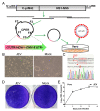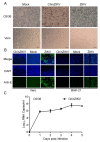Rapid Generation of Recombinant Flaviviruses Using Circular Polymerase Extension Reaction
- PMID: 37515065
- PMCID: PMC10383701
- DOI: 10.3390/vaccines11071250
Rapid Generation of Recombinant Flaviviruses Using Circular Polymerase Extension Reaction
Abstract
The genus Flavivirus is a group of arthropod-borne single-stranded RNA viruses, which includes important human and animal pathogens such as Japanese encephalitis virus (JEV), Zika virus (ZIKV), Dengue virus (DENV), yellow fever virus (YFV), West Nile virus (WNV), and Tick-borne encephalitis virus (TBEV). Reverse genetics has been a useful tool for understanding biological properties and the pathogenesis of flaviviruses. However, the conventional construction of full-length infectious clones for flavivirus is time-consuming and difficult due to the toxicity of the flavivirus genome to E. coli. Herein, we applied a simple, rapid, and bacterium-free circular polymerase extension reaction (CPER) method to synthesize recombinant flaviviruses in vertebrate cells as well as insect cells. We started with the de novo synthesis of the JEV vaccine strain SA-14-14-2 in Vero cells using CPER, and then modified the CPER method to recover insect-specific flaviviruses (ISFs) in mosquito C6/36 cells. Chimeric Zika virus (ChinZIKV) based on the Chaoyang virus (CYV) backbone and the Culex flavivirus reporter virus expressing green fluorescent protein (CxFV-GFP) were subsequently rescued in C6/36 cells. CPER is a simple method for the rapid generation of flaviviruses and other potential RNA viruses. A CPER-based recovery system for flaviviruses of different host ranges was established, which would facilitate the development of countermeasures against flavivirus outbreaks in the future.
Keywords: CPER; Flavivirus; reporter virus; reverse genetic; vaccine.
Conflict of interest statement
The authors declare no conflict of interest.
Figures




Similar articles
-
Detection of Quang Binh virus from mosquitoes in China.Virus Res. 2014 Feb 13;180:31-8. doi: 10.1016/j.virusres.2013.12.005. Epub 2013 Dec 14. Virus Res. 2014. PMID: 24342141
-
Immunopathology of Zika virus infection.Adv Virus Res. 2020;107:223-246. doi: 10.1016/bs.aivir.2020.06.007. Epub 2020 Jul 7. Adv Virus Res. 2020. PMID: 32711730
-
Noncoding Subgenomic Flavivirus RNA Is Processed by the Mosquito RNA Interference Machinery and Determines West Nile Virus Transmission by Culex pipiens Mosquitoes.J Virol. 2016 Oct 28;90(22):10145-10159. doi: 10.1128/JVI.00930-16. Print 2016 Nov 15. J Virol. 2016. PMID: 27581979 Free PMC article.
-
Memory T Cells in Flavivirus Vaccination.Vaccines (Basel). 2018 Oct 18;6(4):73. doi: 10.3390/vaccines6040073. Vaccines (Basel). 2018. PMID: 30340377 Free PMC article. Review.
-
Emerging mosquito-borne flaviviruses.mBio. 2024 Dec 11;15(12):e0294624. doi: 10.1128/mbio.02946-24. Epub 2024 Oct 31. mBio. 2024. PMID: 39480108 Free PMC article. Review.
Cited by
-
The Chimeric Chaoyang-Zika Vaccine Candidate Is Safe and Protective in Mice.Vaccines (Basel). 2024 Feb 19;12(2):215. doi: 10.3390/vaccines12020215. Vaccines (Basel). 2024. PMID: 38400198 Free PMC article.
-
Reverse genetics rescue of sylvatic dengue viruses.J Virol. 2025 Jul 22;99(7):e0045025. doi: 10.1128/jvi.00450-25. Epub 2025 Jun 4. J Virol. 2025. PMID: 40464564 Free PMC article.
-
STAT1-mediated interferon signaling in the hematopoietic system is essential for restricting Usutu virus infection in vivo.PLoS Negl Trop Dis. 2025 Jul 22;19(7):e0013317. doi: 10.1371/journal.pntd.0013317. eCollection 2025 Jul. PLoS Negl Trop Dis. 2025. PMID: 40694555 Free PMC article.
-
Development of ENTV reverse genetics system and phenotypic evaluation of rescued virus reveals host-specific replication patterns in mosquitoes.bioRxiv [Preprint]. 2025 Jul 29:2025.07.29.667424. doi: 10.1101/2025.07.29.667424. bioRxiv. 2025. PMID: 40766458 Free PMC article. Preprint.
-
Bioprofiling and vaccine development for Zika virus.Sci China Life Sci. 2025 Jun 3. doi: 10.1007/s11427-024-2851-4. Online ahead of print. Sci China Life Sci. 2025. PMID: 40471494 Review.
References
-
- Government of Canada Surveillance of West Nile Virus. [(accessed on 19 May 2023)]; Available online: https://www.canada.ca/en/public-health/services/diseases/west-nile-virus....
Grants and funding
LinkOut - more resources
Full Text Sources

